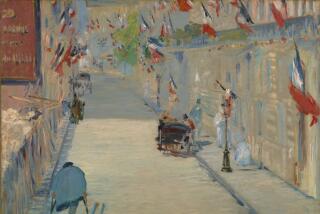Physicist puts time on timeless Monet painting
The Impressionist art movement began Nov. 13, 1872, right around 7:35 a.m. local time.
That’s the moment Claude Monet put brush to canvas to depict a hazy sunrise seen from his hotel room in Le Havre, according to Donald Olson, a physicist at Texas State University, San Marcos.
The name Monet gave to that now famous work, “Impression, Soleil Levant,” (Impression, Sunrise) later was affixed to a school of art marked by its imprecise, subjective depiction of quotidian scenes, executed with loose brush strokes in vivid hues.
Art historians have debated where and when Monet’s work was painted, with many disbelieving the abbreviated date “72” that the artist brushed beside his name. Others even insisted the plummy skies streaked with orange depicted a sunset, rather than sunrise, over the port city on the Normandy coast.
Olson, who dubs himself a “celestial sleuth,” pored over hundreds of photographs and scores of historical maps of Le Havre before determining the precise room that matched the artist’s southeast-facing perspective.
EBay’s French site proved a boon -- scores of historical photos have been posted there, Olson said. Those helped him find the structures depicted in Monet’s “Le Grand Quai,” painted from a balcony of the Hotel de L’Amiraute. A bit of geometry and trigonometry led him to the precise position Monet likely occupied when painting.
Olson next calculated the sun’s height from the horizon and its angle of rise, which determined the time of year and time of day depicted in the painting. He settled on late fall or early winter, at 7:30-8:30 a.m. local time. (Greenwich Mean Time had not be adopted as a worldwide standard, but France’s local times were within a minute of current measures, Olson said. France has since changed the time zone of Le Havre to GMT +1).
Fellow Texas State physicist Ed Piner offered the next breakthrough, Olson said: The tall, multiple-masted ships depicted by Monet likely could not have been in the distant outer harbor unless tides were high.
“That suggests you’re looking at a high tide, near a rising sun in a certain azimuth,” Olson said. But that only narrowed the possibilities to 19 dates spanning from November 1872 to January 1873.
Much to Olson’s surprise, a trove of 19th century daily weather observations in Le Havre harbor went online recently. He matched the sky and weather conditions to six dates in that period, then narrowed them to two days when the observer noted easterly morning winds -- smoke in Monet’s painting drifts slightly from east to west.
On Nov. 15, 1872, at 7:35 a.m., the weather observer noted light winds from the southeast with mist, fog and calm seas.
“All of the times I was considering were between 7:30 and 8:30 a.m.,” Olson said. “So, on exactly the time of day I want to know about, we have a guy looking at the water and looking at the sky. The guy was out there every day at 8 in the morning.”
A weather report on Jan. 25, 1873, also matched conditions and other data, but curators opted for the November date, since Monet dated his painting “72.”
This was far from Olson’s first bout of applying science to art. He and his research team have linked the luridly orange sky of Edvard Munch’s “The Scream” with drifting emissions from the Krakatoa volcanic eruption, and dated a Monet depiction of a sunset near the cliffs on the Normandy coast as well as three Van Gogh works. He also calculated the place where Ansel Adams snapped his shutter to capture an Autumn moon from Glacier Point in Yosemite National Park -- and organized a reenactment of the shot, under similar celestial conditions, in 2005.
Olson had puzzled over the sunrise over Le Havre for 15 or more years, putting it aside for other projects. After publication in February of his work on the other Monet painting, “The Cliff, Etretat, Sunset,” French curators urged Olson to reexamine the Le Havre sunrise -- they were planning an exhibition that opens Sept. 18 at the Musee Marmottan Monet in Paris.
The museum published a “biography” of the Monet work, co-written by Olson, in conjunction with the exhibit, which runs through Jan. 18.
Like a bit of art with your science? Follow: @LATsciguy







